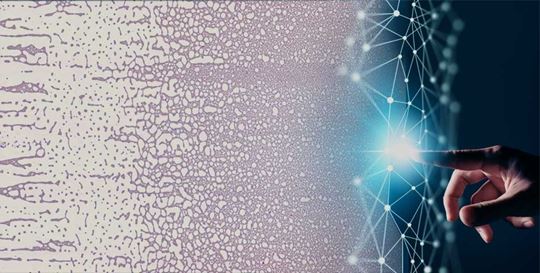Digital Cell Morphology Analysis
Discover the potential of real-time, remote collaboration
Maximize Network workflow efficiency
In today’s modern clinical lab, the heavy lifting of the complete blood count with differential (CBC-Diff) is performed by automated hematology analyzers. However, even with advances in hematology analyzer technology, manual examination of peripheral blood smears has been shown to be requested in up to 17% of cases.1 The blood smear provides a visual of the cells present in the bloodstream at any given point in time. Blood cell morphology can add significant value to the routine CBC-Diff, even when the CBC-Diff counts are within the normal ranges.2 Blood cell morphology can be used to look for abnormalities in the shape or quantity of cells;3,4 anemias, cancers and platelet or leukocyte disorders;5,6 or the presence of some blood-borne parasitic infections.7,8
While seemingly simple on the surface, peripheral blood smear evaluation is both time consuming and labor intensive.9,10 Manually evaluating blood smears, even for those with extensive training, can result in significant intra- and inter-operator variability.11 Even with all of the available technology, a skilled morphologist must review all blood smears for morphological review and diagnostic interpretation.12
In healthcare, ever-increasing workloads and continually decreasing staffing are putting pressure on laboratory output.13 Clinicians rely on the results of laboratory testing. High laboratorian vacancies due to the pandemic14 and burnout15 have led to current laboratorians being asked to work longer hours, leading to exhaustion and an increased likelihood of errors as well as potential delays in treatment.13,16 Hospital and laboratory networks are primed to consolidate and make more efficient use of their resources, yet fast and easy access to morphology expertise continues to be a challenge—ushering in the need for remote collaboration. Implementing collaborative systems improves efficiency and allows teams to share clinical specialists, both within and outside the hospital’s physical boundaries.
From the monolayer to feathered edge—Viewing what matters
Recent advances in digital hematology have helped to ease the burden on clinical laboratories and cell morphologists. For example, the Slidemaker Stainer Cellular Analysis System automatically prepares slides based on orders received from the integrated hematology analyzer into the work cell and/or from the Laboratory Information System (LIS).
A well-made blood smear has several parts. The smear base is the thick area where the blood drop was initially placed. Because of its thickness, it dries more slowly than the rest of the slide, which can lead to cellular distortion. This region can be so dense that it becomes difficult to identify individual cells, so it usually isn’t viewed. The middle region of the slide is the monolayer. Because the cells are spread out in the monolayer, it is easier to identify individual cell types. The monolayer is the best place for differential cell counting and cell examination.17 Finally, the feathered edge is found at the end of the smear. Examination of the peripheral blood smear’s feathered edge can aid in the identification of conditions such as pseudothrombocytopenia18,19 and the presence of microfilaria.20
To be Truly Remote, Context Matters
True remote collaboration in hematology digital cell morphology was not available until recently.9,21 In the past, digital cell morphology technology focused on a “snapshot” of a cell, which can provide an accurate, close-up view of a single cell but, because the technology was not able to scan the monolayer to the feathered edge, didn’t provide the cellular context in the patient sample. Personnel specially trained to evaluate blood smears either received a high-resolution image of individual cells with no context or an overview image in low resolution. The morphologist or hematopathologist either had to be physically present in the lab or was only able to look at individual cells. When questions arose with these older systems and context was required, the reviewer had to go back to the manual microscope, which required either going into the laboratory or having the slide sent from a remote location—both of which are inconvenient and time consuming.
With the introduction of Scopio Labs X100 and X100HT scanners, you have a digital image of the clinically relevant part of the smear. Scopio’s Full-Field Digital Cell Morphology™ technology reduces the time9 and tedium associated with manual microscope reviews. And being able to see cells both in full context and zoomed into the smallest detail is vital for confident clinical decision-making.
Clinical-grade AI decision support for insightful peripheral blood smear reviews
Incorporating AI-supported decision making and fully documented digital reporting allows analysis of tens of thousands of cells, leading to faster, more repeatable results—improving every aspect of the hematology workflow and contributing to better patient outcomes.
Scopio’s remote collaboration capabilities increase productivity and efficiency with a simplified and seamless process that facilitates easy communication through digital annotations of the patient sample, replacing chaos with annotatable cases for authorized morphology experts accessing the hospital’s secure network to review—and sign off on—from anywhere.

 English
English





